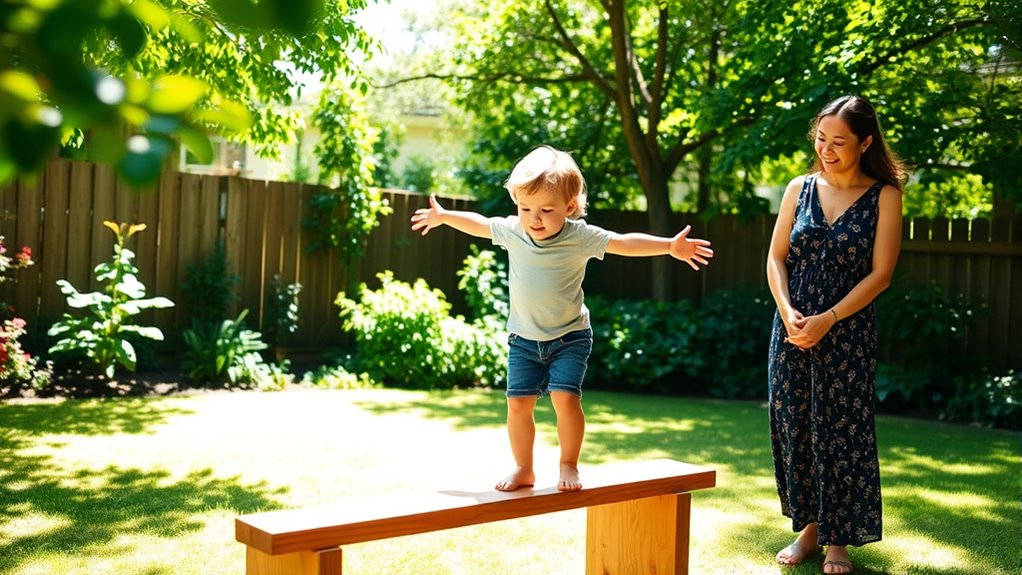To encourage independence while letting kids make mistakes safely, give them chances to make age-appropriate choices and experience natural consequences. Focus on guiding rather than controlling, and create a safe environment for them to take calculated risks. Support their efforts, celebrate progress, and share your own experiences with setbacks. By doing so, you’ll help build their confidence, resilience, and decision-making skills—learn more about fostering independence in your child as you continue to explore this approach.
Key Takeaways
- Create a safe environment that allows children to take age-appropriate risks and learn from mistakes without fear of harsh consequences.
- Offer choices in daily activities to foster decision-making skills and demonstrate trust in their judgment.
- Share personal stories of setbacks to normalize failure and teach resilience as part of growth.
- Balance guidance and independence, supporting children through challenges while encouraging self-reliance.
- Reinforce that mistakes are valuable learning opportunities, helping children develop confidence and a growth mindset.

Have you ever wondered how to help someone develop confidence and self-reliance? One of the most effective ways is by encouraging them to take risks and make decisions on their own. When kids learn to navigate challenges and face the possibility of failure, they build resilience and trust in their abilities. Risk taking isn’t about reckless behavior; it’s about stepping outside comfort zones in a safe environment where mistakes become valuable lessons. As they experience the consequences of their actions, children gain a clearer understanding of what works and what doesn’t, fostering a sense of independence that lasts. Additionally, providing appropriate retail hours can help parents access resources and activities that support their children’s growth. Supporting decision making plays a vital role in this process. You can empower kids by giving them opportunities to choose and make choices appropriate for their age. Let them decide what to wear, what game to play, or how to approach a problem. When they see that their decisions matter and that they’re capable of handling the outcomes, their confidence grows. It’s essential to remind them that mistakes are part of learning, not failures. When they stumble, instead of stepping in immediately, guide them to reflect on what went wrong and how they might do better next time. This approach helps them develop critical thinking skills and trust in their judgment. Creating a safe space for risk taking means being there to support, not to control. If you constantly intervene or shield them from every potential mistake, you hinder their ability to learn independence. Instead, encourage them to take calculated risks—like trying a new sport, speaking up in class, or attempting a challenging project—while reassuring them that you’re there to help if needed. This balance teaches them that they’re capable of handling difficulties and that failure isn’t the end but an opportunity to grow. You can also model healthy risk taking and decision making yourself. Share stories of your own mistakes and how you’ve learned from them. When children see that even adults face setbacks and still move forward, it normalizes the process and reduces their fear of failure. Remember, the goal isn’t to eliminate mistakes but to teach kids that they have the strength to take risks, make decisions, and learn from the results. Over time, this cultivates a mindset of independence, resilience, and self-trust that will serve them throughout life.
Frequently Asked Questions
How Can Parents Balance Safety With Independence?
Balancing safety with independence involves effective risk management and boundary setting. You should assess potential risks and set clear boundaries, allowing your child to explore within safe limits. By doing so, you help them build confidence and resilience while ensuring their safety. Encourage your child to take age-appropriate risks, and stay involved to guide their decision-making. This approach fosters independence without compromising safety.
What Are Signs My Child Is Ready for More Independence?
You might worry your child isn’t ready for more independence, but signs like emotional readiness and strong problem-solving skills show they are. If they can handle small challenges calmly and make decisions confidently, it’s a good sign. Watch for increased curiosity and responsibility. When they demonstrate these traits, it’s time to gradually give them more freedom, trusting they can navigate new experiences safely and learn from them.
How Do Cultural Differences Affect Independence Training?
Cultural differences shape how you view independence training, as cultural norms influence perceptions of what kids should handle alone. You might find that in some cultures, independence is encouraged early, while others prioritize safety and family involvement. Recognizing these varying expectations helps you adapt your approach, respecting your child’s development within your cultural context. Understanding these influences allows you to support independence in ways that feel right for your family.
When Should I Intervene During My Child’s Mistakes?
Think of your child’s mistakes as seeds for growth. You should intervene when the risk assessment shows danger to their safety or well-being. If the mistake is minor and their emotional support is intact, let them learn. Offer guidance and reassurance, but don’t jump in too early. Your calm presence helps them understand boundaries and develop resilience, turning mistakes into valuable lessons rather than setbacks.
How Can I Rebuild Trust After a Discouraging Mistake?
When rebuilding trust after a discouraging mistake, focus on building confidence and fostering resilience. You can do this by openly acknowledging the mistake without blame, showing understanding, and emphasizing that everyone makes errors. Encourage your child to reflect on what they learned and celebrate small successes moving forward. Your support helps them see setbacks as growth opportunities, strengthening trust and empowering them to try again with a positive mindset.
Conclusion
By allowing your children to navigate their mistakes gently, you’re gently guiding them toward resilience and confidence. Every stumble is a quiet lesson, a tender step toward independence. When you create a safe space for these small missteps, you’re nurturing their growth with love and patience. Remember, sometimes the kindest thing you can do is let them find their way, even if it means a few gentle lessons along the path.









